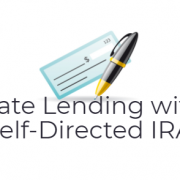What You Need to Know About Private IRA Lending
These days, people want to know about diversification. And while it is good to look to real estate and precious metals for diversification, there is one way that retirement investors can access diversification in a way that may not have occurred to them at first: Private IRA Lending.
Why Private IRA Lending? Well, it is up to each individual investor to make their own investment decisions when they use a Self-Directed IRA. But we can tell you why some people flock to Private IRA Lending. These loans can mean they access positive returns that help diversify from other assets. These loans allow a great deal of wiggle room in a variety of economic circumstances, since the terms of the loan are negotiated between two parties. And in that way, it’s another strategy investors sometimes use to decouple from the returns of the stock market. But it has to be done in the right way.
Essential Facts About Private IRA Lending
With a Self-Directed IRA, you will gain access to a wide variety of investment asset classes. For instance, real estate, precious metals, and private notes are all within the scope of a Self-Directed IRA. With Private IRA Lending in particular, you have a highly independent style of investing, since this style of investing is between your IRA and another party.
Smaller lenders, for example, can facilitate the financing needs for individuals. Lending from a Self-Directed IRA can be done by streamlining the underwriting procedures; in return, the borrower gets quick funding. And for the investor, this can mean an exchange of higher interest rates—even above market rates for bank loans. In other words, it is possible for investors to generate passive income into a retirement account that goes above the typical market rates on debt.
What Kinds of Loans Might Be Included?
Of course, a loan is a generic term. But there are specific types of loans for which people might apply, and many of these are available within a Self-Directed IRA. That includes mortgages and trust deeds, secured notes, unsecured notes, private business loans, commercial real estate development, car notes, and property tax liens and deeds.
This is a wide variety of notes available to investors who want to make investments that are outside the stock market and other traditional retirement asset classes, such as bonds. In that way, it can be a direct way for a retirement account to hold debt owed to it. In addition, an investor can purchase “distressed debt” and hold it within a Self-Directed IRA.
The Rules of Self-Directed IRA Lending
Of course, there is a catch: you have to make sure that you know your limits. And just like any investment, these are investments that come with risks.
You can use Self-Directed IRA lending to structure specific repayment terms and setup your own interest rates with the borrower, and these rates do not have to be perfectly in line with the market rates you might see at the bank. However, make sure you understand all of the rules and regulations in your state and at the Federal level before you begin.
You can also choose whether promissory notes are secured or unsecured with a Deed of Trust.
Make sure that you also work only with people who are not immediate relation or can provide no personal benefit to you, otherwise known as “disqualified persons.” For example, you would not loan money from a Self-Directed IRA to a family member.
Interested in learning more about Self-Directed IRAs? Contact American IRA, LLC at 866-7500-IRA (472) for a free consultation. Download our free guides or visit us online at www.AmericanIRA.com.






